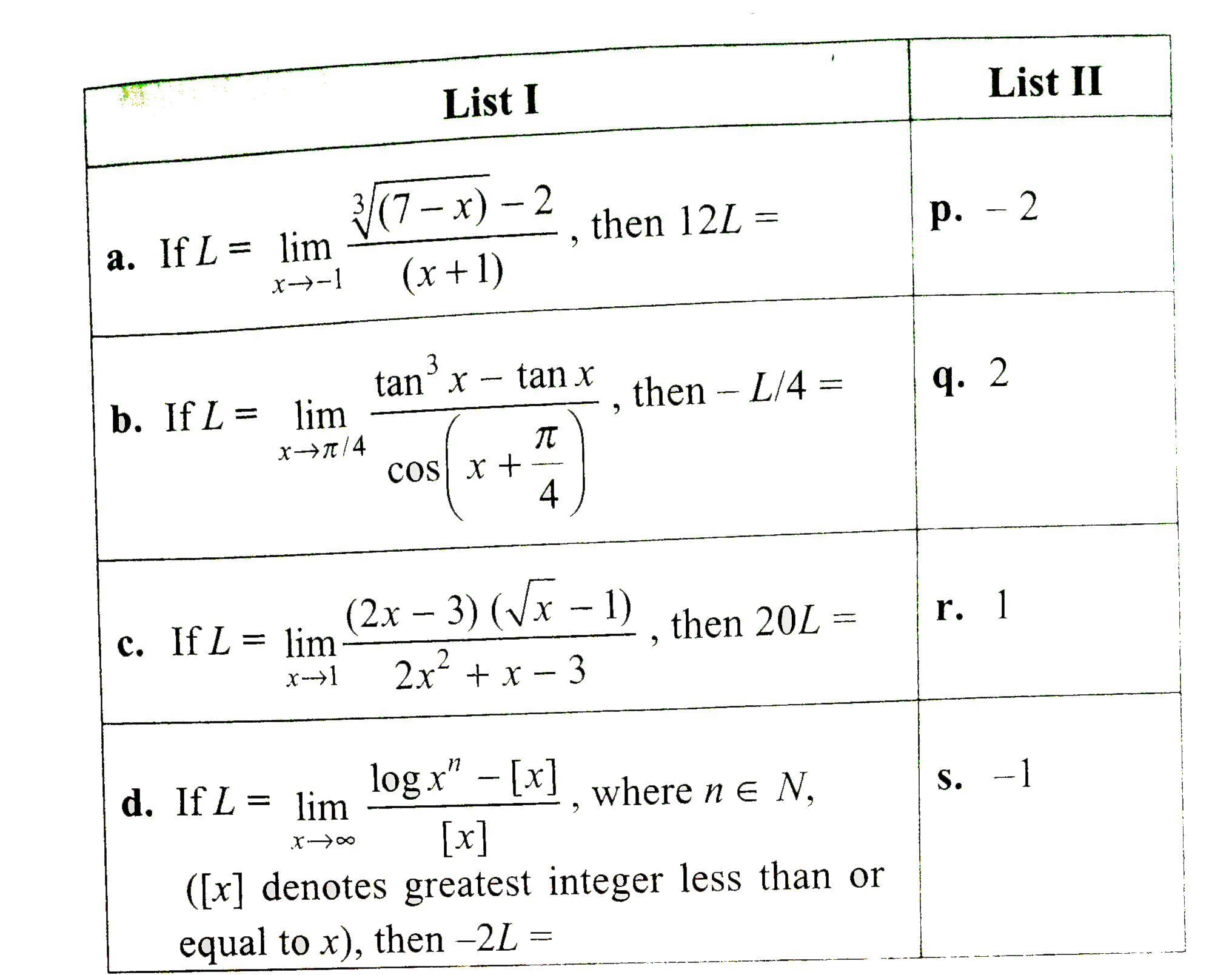If f(a)=limx→2(sinxa+cosxa)1(x−2) for a∈[0,π2], thenSolution in Tamil
−np
np
n2p
np2
The correct Answer is:A, B, C
f(a)=limx→2(sinxα+cosxα)1(x−2) (1∞ form)
=⎧⎪⎨⎪⎩elimx→2sinxα+cosxα−1x−2,α∈(0,π2)1, α=0, π2
Now elimx→2sinxα+cosxα−1x−2=elimx→2sinxα+cosxα−sin2α−cos2αx−2
=elimx→2sin2α(sinx−2a−1)+cos2α(cosx−2α−1)x−2
=esin2αlogesinα+cos2αlogecosα
=eloge(sinα)sin2α+loge(cosα)cos2α
=eloge(sinα)sin2α(cosα)cos2α
=(sinα)sin2α(cosα)cos2α
∴f(x)=⎧⎨⎩(cosα)cos2α.(sinα)sin2α, α∈(0, π2)1, α=0, π2
Topper's Solved these Questions
- BOOK - CENGAGECHAPTER - LIMITSEXERCISE - Exercise (Comprehension)20videos
LIMITS
- BOOK - CENGAGECHAPTER - LIMITSEXERCISE - Exercise (Matrix)5videos
LIMITS
- BOOK - CENGAGECHAPTER - LIMITSEXERCISE - Exercise (Single)76videos
LIMITS
- BOOK - CENGAGECHAPTER - JEE 2019EXERCISE - Chapter 109videos
JEE 2019
- BOOK - CENGAGECHAPTER - LINEAR COMBINATION OF VECTORS, DEPENDENT AND INDEPENDENT VECTORSEXERCISE - DPP 1.210videos
LINEAR COMBINATION OF VECTORS, DEPENDENT AND INDEPENDENT VECTORS
Similar Questions
Find the domain of f(x)=√|x|−{x} (where {⋅} denots the fractional part of x).
07:55View SolutionMatch the following lists:
 07:55View Solution
07:55View Solution(lim)x→0[sin(sgn(x))(sgn(x))], where[.] denotes the greatest integer function, is equal to (a)0 (b) 1 (c) −1 (d) does not exist
01:38View SolutionIf y = y(x) is the solution of the differential equation, xdydx+2y=x2 satisfying y(1) = 1, then y(12) is equal to
08:57View SolutionThe number of integral values of p for which (p+1)ˆi−3ˆj+pˆk,pˆi+(p+1)ˆj−3ˆk and −3ˆi+pˆj+(p+1)ˆk are linearly dependent vectors is q
13:06View SolutionIf f(x)=0 be a quadratic equation such that f(−π)=f(π)=0 and f(π2)=−3π24,then limx→πf(x)sin(sinx) is equal to:
05:09View SolutionIf f(x)=0 be a quadratic equation such that f(-pi)=f(pi)=0 and f((pi)/(2))=(-3 pi^(2))/(4), then lim_(x rarr pi)(f(x))/(sin(sin x)) is equal to:
01:36View SolutionStatement 1: Let f(x)=sin(cosx)∈[0,π2]. Then f(x) is decreasing in [0,π2] Statement 2: cosx is a decreasing function ∀x∈[0,π2]
01:40View SolutionConsider a function,f(x)=(2)/(3)ln(sin x+cos x)^((3)/(2)) for x in(0,(pi)/(2)) The value of lim_(x rarr(pi)/(2))(f(x))/((pi)/(2)-x) is
01:12View SolutionLet f(x)={x^(3)+x^(2)-10x,-1<=x<=0,sin x,0<=x<(pi)/(2),1+cos x,(pi)/(2)<=x<=pi then 'f(x) has
06:34View SolutionLet f(x) be a quadratic function such that f(0)=f(1)=0&f(2)=1, then lim_(x rarr0)(cos((pi)/(2)cos^(2)x))/(f^(2)(x)) equal to
03:46View SolutionFor a in R^(+) such that lim_(x rarr0)(1-cos ax)/(x^(2))=lim_(x rarr pi)(sin x)/(pi-x) then the value of a is
View SolutionFor a in R^(+) such that lim_(x rarr0)(1-cos ax)/(x^(2))=lim_(x rarr pi)(sin x)/(pi-x) then a=
03:08View Solutionlim_(x rarr 0) sin(pi cos^2x)/x^2=
04:39View SolutionIf f(a)=limx→2(sinxa+cosxa)1(x−2) for a∈[0,π2], then
05:51View SolutionStatement 1: If f(x)=2πcot−1(3x2+1(x−1)(x−2)), then limx→1−f(x)=0 and limx→2−f(x)=2
Statement 2: limx→∞cot−1x=0 and limx→−∞cot−1x=π03:36View Solution

